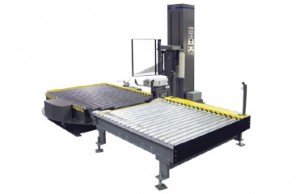Before we get to the grand finale lets cover one more quick, but important subject, Pallet Load Configurations. Pallet load configurations are classified as A, B or C.
- A. Is a square uniformed load that’s easily wrapped.
B. Is a somewhat irregular load that’s more difficult to wrap.
C. Consists of a very irregular load with many corners and protrusions making it extremely difficult to wrap.

Now that you have some knowledge regarding the type of machine and the way it stretches the film you should be able to make an intelligent stretch film selection. Keep in mind that it doesn’t make sense to choose a premium, high performance film for a force to load type stretch film machine. Why? Because the machine isn’t capable of getting the performance value out of the stretch film. Nor does it make much sense to use a very thin film to wrap a heavy “C” load.
The least appropriate way to selecting a machine grade of stretch film is on a price per roll basis without consideration of the machine and films’ capabilities, and make up of the load. Manufacturers are further complicating price per roll comparisons by offering metric gauges and widths of rolls, and rolls of varied lengths.
The best way to select a machine grade stretch film is by testing its performance in your application. If price comparisons are to be made, make sure to compare the cost of stretch film actually used to wrap a load. This is easily done by determining the stretch film’s price per pound and then weighing the film used per load.
